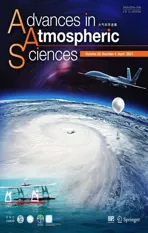Monthly Variations of Atmospheric Circulations Associated with Haze Pollution in the Yangtze River Delta and North China
2021-04-07XinyuZHANGZhicongYINHuijunWANGandMingkengDUAN
Xinyu ZHANG,Zhicong YIN*,2,3,Huijun WANG,2,3,and Mingkeng DUAN
1Key Laboratory of Meteorological Disaster, Ministry of Education/Joint International Research Laboratory of Climate and Environment Change/Collaborative Innovation Center on Forecast and Evaluation of Meteorological Disasters,Nanjing University of Information Science and Technology, Nanjing 210044, China
2Southern Marine Science and Engineering Guangdong Laboratory (Zhuhai), Zhuhai 519080, China
3Nansen-Zhu International Research Centre, Institute of Atmospheric Physics,Chinese Academy of Sciences, Beijing 100029, China
ABSTRACT Haze pollution in early winter (December and January) in the Yangtze River Delta (YRD) and in North China (NC)are both severe;however,their monthly variations are significantly different.In this study,the dominant large-scale atmospheric circulations and local meteorological conditions were investigated and compared over the YRD and NC in each month.Results showed that the YRD (NC) is dominated by the so-called Scandinavia (East Atlantic/West Russia)pattern in December,and these circulations weaken in January.The East Asian December and January monsoons over the YRD and NC have negative correlations with the number of haze days.The local descending motion facilitates less removal of haze pollution over the YRD,while the local ascending motion facilitates less removal of haze pollution over NC in January,despite a weaker relationship in December.Additionally,the monthly variations of atmospheric circulations showed that adverse meteorological conditions restrict the vertical (horizontal) dispersion of haze pollution in December(January) over the YRD,while the associated local weather conditions are similar in these two months over NC.
Key words:monthly haze pollution,atmospheric circulations,Yangtze River Delta,North China
1.Introduction
Heavy haze pollution often occurs in winter (December—February) in North China (NC) and the Yangtze River Delta (YRD) (Ding and Liu,2014).Haze pollution is mainly characterized by high concentrations of fine particulate matter and reduced visibility,causing serious socioeconomic problems (Wang and Chen,2016).Thus,haze pollution has aroused widespread concern in government and among the public.Early studies showed that haze pollution is not only affected by anthropogenic emissions (mainly the long-term trend of haze),but also by climate variability(mainly the interannual variations) (Wang et al.,2013;Yang et al.,2016;Zhang et al.,2016).
Several researchers have investigated the pollution situation over the YRD from monthly,seasonal and annual mean perspectives (Yu et al.,2011;Zhao et al.,2017;Sun et al.,2019).Affected by urbanization,large cities in the YRD have higher aerosol optical depths than remote areas (Sun et al.,2019),as well as high anthropogenic heat release (Wang et al.,2015),as verified by high-resolution Weather Research and Forecasting model results.In addition to impacts of anthropogenic emissions on the long-term trend of haze pollution in the YRD,a few studies have investigated the roles of weather—climate conditions in the YRD.He et al.(2019b) pointed out that PMthroughout the Yangtze River Basin is negatively correlated with surface wind speed,precipitation and planetary boundary layer height (PBLH) but positively correlated with temperature.High wind speed,more precipitation and a well-developed boundary layer could facilitate the dispersion of aerosols and lead to a decrease in PM(He et al.,2019b).The positive relationship between temperature and PMis possibly due to the enhancement in oxidation of aerosol precursors at high temperatures (He et al.,2019b).Compared to the conditions in NC,He et al.(2019a) also indicated that wet removal of haze brought by precipitation over southern China (south of 30°N) is important.Furthermore,winter haze extremes in India at lower latitudes are even affected by El Niño sea surface temperature and signals from the Southern Hemisphere (Gao et al.,2019).
NC is the most haze-polluted area in China,and the associated atmospheric circulations have already been examined in previous studies.The number of winter haze days (HDs)in NC (WHD) has been found to be directly dominated by local anticyclonic circulations (Chen and Wang,2015;Yin and Wang,2016),connected by two Rossby wave trains [i.e.,the East Atlantic/West Russia (EA/WR) and Eurasia patterns]over the continent and one Rossby wave train (i.e.,the West Pacific pattern) over the ocean (Wallace and Gutzler,1981;Barnston and Livezey,1987).These wave trains provide the favorable atmospheric conditions associated with haze pollution,such as a lower planetary boundary layer,lower wind speed,anomalous southerlies,and higher relative humidity (RH),which restrict the horizontal and vertical ventilation of haze particles (Yin et al.,2017).
The number of HDs in December over the YRD(DHD),as well as those in January (JHD),slowly increased from 1981 to 2017,while those over NC (DHDand JHD) slightly decreased from 1981 to 2010 but increased from 2011 to 2017 (Fig.1).In this study,we pay more attention to the interannual variations of monthly haze pollution.The correlation coefficient (CC) between DHDand JHDis 0.71;however it decreases to 0.33 in the YRD,indicating significant differences in haze variations in December and January over the YRD.The time series of DHDand DHD(JHDand JHD) during 1981—2017 has a CC of 0.49 (0.2),which are not high for two adjacent economically developed regions (Figs.1a and b).Furthermore,we also compared the variations in emissions (i.e.,the difference of emissions in different months and regions) with the associated differences in HDs and found the CCs between them were all lower than 0.2 [non-significant;Fig.S1 in electronic supplementary material(ESM) ].The above statistical results illustrate the need for an analysis of the monthly variations of atmospheric circulations associated with haze pollution (i.e.,the impacts of meteorology) in the YRD and NC.
2.Datasets and methods
The monthly geopotential height,horizontal wind(UV),vertical wind (omega),temperature,and RH at different levels for the winters of 1981—2018,as well as surface RH,surface UV,surface air temperature,and sea surface level,are from the NCEP—NCAR reanalyses with a horizontal resolution of 2.5° × 2.5° (Kalnay et al.,1996).The precipitation data are from Climate Prediction Center Merged Analysis of Precipitation (CMAP),with a horizontal resolution of 2.5° × 2.5°,in winters from 1981 to 2018 (Xie and Arkin,1997).Other precipitation data,including the 1° × 1°Precipitation Reconstruction over Land of the National Oceanic and Atmospheric Administration,as well as a station dataset of the China Meteorological Administration(Chen et al.,2002),were used to verify the results.Monthly PBLH data are also used here (resolution:1° × 1°),but were derived from the ERA-Interim dataset with the same time period as the above datasets (Dee et al.,2011).In addition,the EA/WR and Scandinavia patterns are two of three prominent teleconnection patterns that affect Eurasia,and have been referred to as the Eurasia-2 and Eurasia-1 pattern,respectively (Barnston and Livezey,1987).The EA/WR pattern is composed of two positive height anomaly centers over Europe and northern China,and two negative height anomaly centers over the central North Atlantic and north of the Caspian Sea,when in positive phase.The Scandinavia pattern has four centers in Eurasia (i.e.,Spain and the adjacent Mediterranean and Atlantic area,Scandinavia,Northwest China or western Mongolia,and Japan),and sometimes some centers do not show up.The calculation procedures for these two indices are available at https://www.cpc.ncep.noaa.gov/data/teledoc/teleindcalc.shtml,and numerical values were downloaded from https://www.cpc.ncep.noaa.gov/data/teledoc/telecontents.shtml.The emissions inventory data are from http://inventory.pku.edu.cn/.The calculations for atmospheric circulations,including the anomalous anticyclone (AAC),surface air temperature (SAT),surface temperature difference between the north and south (SAT diff.),RH,PBLH,surface wind speed (UV speed),and precipitation,are as follows.The areas calculated as AAC indices are shown in Figs.2a and b for December and Figs.2c and d for January.The areas calculated as SAT diff.indices are[R1 (38°—70°N,85°—130°E) − R2 (8°—23°N,95°—120°E)]and [R1 (36°—53°N,83°—115°E) − R2 (15°—19°N,110°—115°E)]in December and January,respectively.Other variables’ indices are defined as area-averaged values of the studied areas (the YRD and NC).
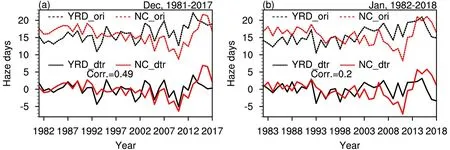
Fig.1.(a) Variation of December haze days (HDs) in the Yangtze River Delta (YRD) and in North China (NC) from 1981 to 2017.(b) Variation of January HDs in the YRD and in NC from 1982 to 2018.Solid (dotted) lines represent detrended (original) data.The correlation coefficients (CCs) of two solid lines are shown in the spaces.
As for haze pollution,the number of HDs in each month in the winters of 1981—2017 were adopted owing to the lack of long-term PMdata.Haze was calculated by defining visibility less than a certain threshold,which was 10 km before 1 January 2014 for most stations and 7.5 km after because of the switch in visibility observation means(i.e.,from manual observation to automatic observation)according to a report of the China Meteorological Administration in 2014 (Yin et al.,2017) and RH less than 90% (Chen and Wang,2015;Yin and Wang,2016).One HD at a station was defined as a day with haze at any time,after excluding other weather phenomena that affected visibility.All the HDs of a month at all stations in the region were accumulated,and then the average value of all stations in the region was calculated as the HDs in the region.HDs over the YRD(27.05°—33.77°N,118.15°—121.95°E) and NC (34°—42°N,114°—120°E) were computed as the HD average value in these two areas,respectively.For more detail,readers are referred to Chen and Wang (2015),Yin and Wang (2016),and Yin et al.(2017).
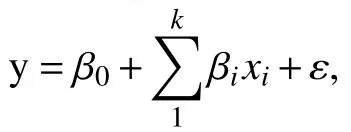
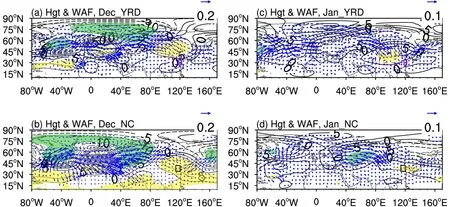
Fig.2.(a) Regressions of December geopotential height (contours;units:m) and the associated wave activity flux(WAF;arrows;units:m2 s−2) at 500 hPa on the December HDs in the YRD during 1981—2017.(b) As in (a) but in NC.(c) Regressions of the January geopotential height (contours;units:m) and the associated WAF (arrows;units:m2 s−2) at 500 hPa on the January HDs in the YRD during 1982—2018.(d) As in (c) but in NC.Solid lines and dotted lines represent positive and negative values of regression,respectively.Shaded regions indicate that the 500-hPa geopotential height anomalies are significant at the 95% confidence level,and yellow (green) color represents positive (negative) regression coefficients passing the Student’s t-test.The linear trend of the data was removed.The purple (gray) solid-line box indicates the location of the YRD (NC).The orange dotted-line boxes in (a,b)respectively indicate the regions of the AAC indices of the YRD (38°—60°N,90°—123°E) and NC (30°—49°N,100°—135°E) in December.The orange dotted-line boxes in (c,d) respectively indicate the regions of the AAC indices of the YRD (30°—49°N,85°—115°E) and NC (35°—40°N,115°—135°E) in January.
3.Results
3.1.Atmospheric circulations drive the monthly variations in haze
The atmospheric circulations associated with December and January haze pollution in the YRD were investigated.As illustrated in Fig.2a,a Rossby wave—like train at middle and high latitudes of continental Eurasia strongly contributes to the variations in DHD.In comparison,in January,the Rossby wave train becomes non-significant,and the only significant centers are the local AAC located in the northwest of the YRD (Fig.2c).That is,the large-scale atmospheric circulation affecting HDs degenerate to the local anticyclone from December to January.Lower PBLH (Fig.3c)in December is apparent because of anomalous descending motions (Fig.3a) over the YRD.Weak surface wind speed,induced by anomalous southerly wind,is apparent in January over the YRD (Fig.3d).Thus,the vertical movement(Figs.3a and c) is restricted in December and the horizontal movement (Figs.3b and d) is restricted in January,over the YRD,leading to high contemporaneous HDs.Furthermore,the anomalous precipitation plays a critical role in the removal of haze particles over the YRD (Figs.4a and b).Precipitation and HDs over the YRD show a significant outof-phase relationship in both December (CC=−0.34) and January (CC=−0.46) (Figs.4a and b).
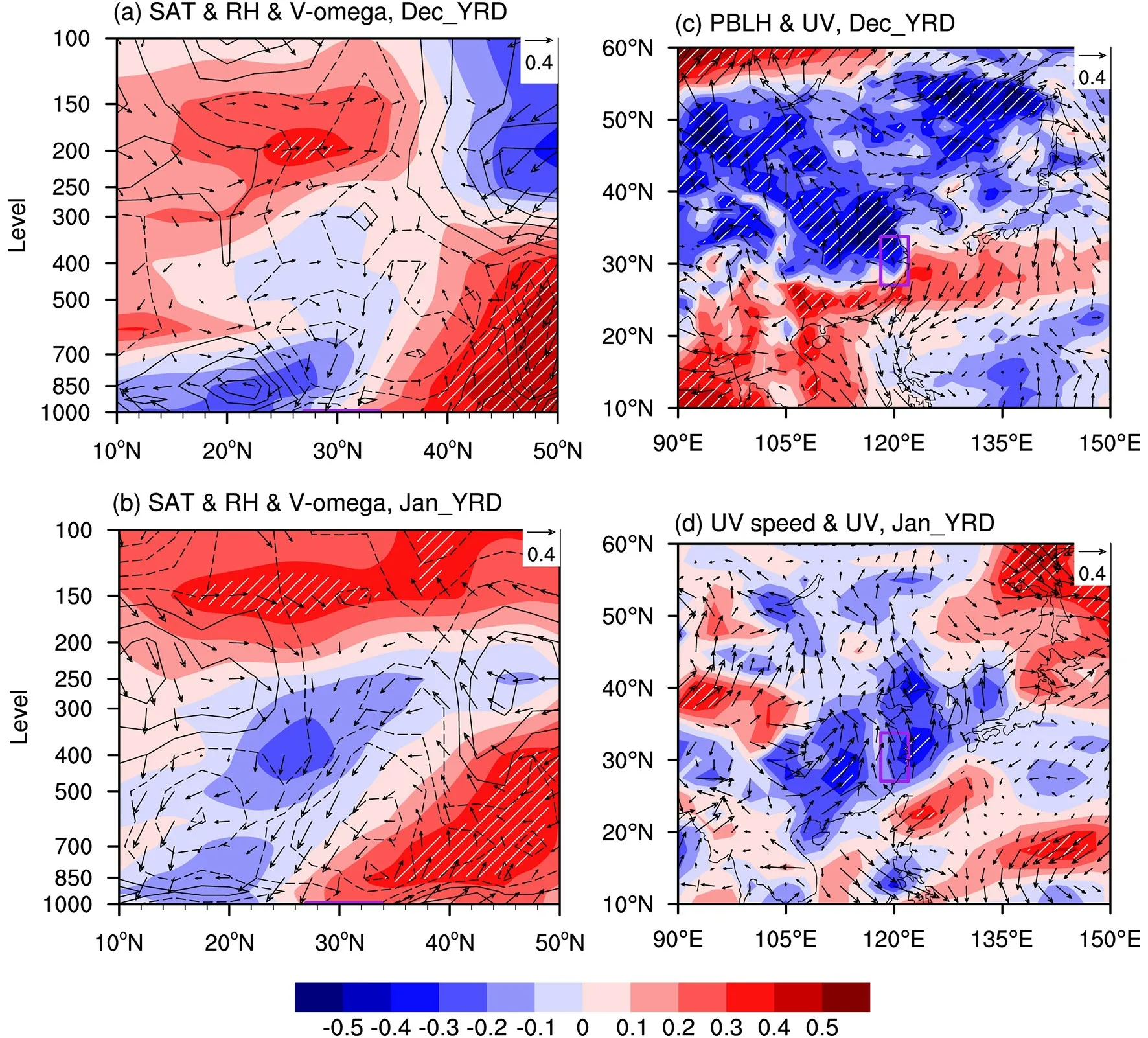
Fig.3.(a) Cross-section (115°—125°E mean) CCs between December HDs in the YRD and December air temperature (shading),RH (contours),and wind (arrows).(b) As in (a) but in January.(c) The CCs between December HDs in the YRD and December PBLH (shading) and surface wind (arrows) from 1981 to 2017.(d) The CCs between January HDs in the YRD and January surface wind speed (shading) and surface wind (arrows) from 1982 to 2018.All the above CCs share the same colorbar at the bottom of the figure.The south wind component in the meridional direction (a—d),the east wind component in the latitudinal direction (c,d),and the ascending movement in the vertical direction (a,b;owing to omega multiplied by −1) are positive,and vice versa.White slanted lines indicate that the CCs represented by the shading exceed the 95% confidence level.The linear trends of all data were removed.The purple box or purple line indicates the location of the YRD.
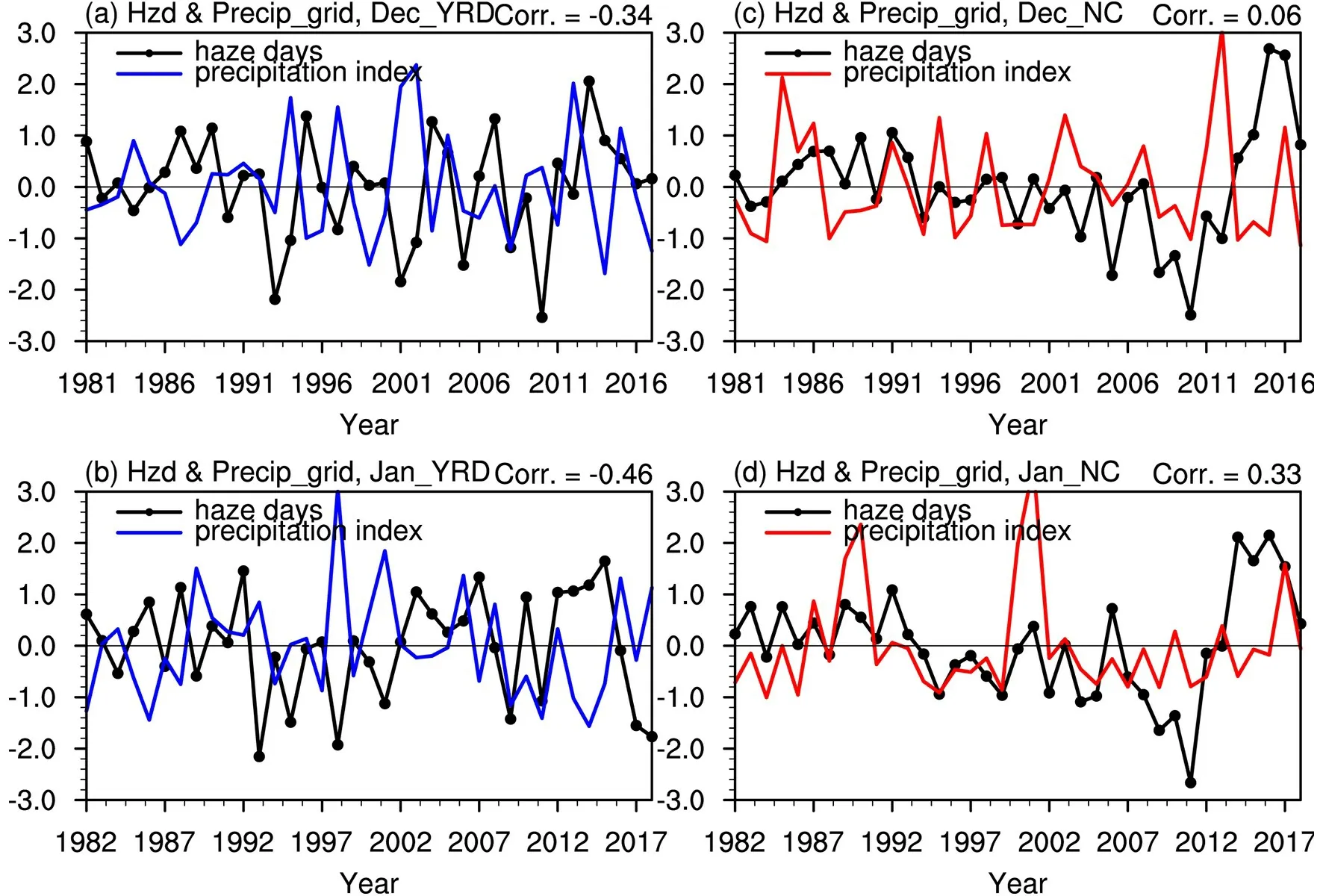
Fig.4.(a) Variation of December HDs in the YRD and the December area-averaged precipitation from CMAP datasets,with their CC in the top-right corner.(b) Variation of January HDs in the YRD and January area-averaged precipitation from CMAP datasets,with their CC in the top-right corner.(c,d) As in (a,b) but in NC.The linear trends of all data were removed.
Atmospheric circulations associated with haze pollution in NC in December and January were also examined.In the mid-troposphere,a Rossby wave—like train clearly affects the haze pollution over NC in December (Fig.2b).However,in January,the associated atmospheric circulations become relatively local (Fig.2d),which is different from the results revealed in many previous studies for the whole winter season (Chen and Wang,2015;Yin and Wang,2016).Anomalous ascending motion (Figs.5a and b),warming near the surface (Figs.5a and b),southerly wind (Figs.5c and d),weak surface wind speed (Figs.S2a in the ESM and 5d),low PBLH (Figs.5c and S3a),high potential of thermal inversion,i.e.,the air temperature at 925 hPa minus the air temperature at 1000 hPa (Figs.S2b and S3b),and high RH (Figs.5a and b,Figs.S2c and S3c),are favorable for both DHDand JHD.That is,the monthly variations of associated local weather conditions are similar.However,precipitation makes different contributions to DHDand JHD.December precipitation is almost unrelated to DHD(Fig.4c),while January precipitation has a significantly positive relationship with DHD(CC=0.33,exceeding the 95% confidence level;Fig.4d).
From the data in Table 1,we can see that the AAC index is crucial for both DHDand DHD,while the SAT diff.index and precipitation index (SAT index,RH index,PBLH index and UV speed index) play important roles in the YRD (NC).To quantify the contributions of atmospheric circulations to haze pollution,the highly correlated variables (≥ 95% confidence level) were selected to regress on the number of HDs.In other words,the AAC,SAT diff.and precipitation indices (ACC,SAT,RH,PBLH and UV speed indices) in December were selected as regression factors of DHD(DHD).The predicted DHDand DHDdid not include the observed trend here,and in the last calculation step we added the trend as fitted values,shown in Fig.6.The fitted and observed DHDand DHDhad a CC of 0.77 and 0.67 for the YRD and NC,respectively (Figs.6a and b).That is,atmospheric circulations made variance contributions of 59% and 45%,respectively (Figs.6a and b),confirming that these circulation variables have large influences on DHDand DHD.DHDhad the same sign as the AAC (SAT difference between the north and the south of the YRD) in 33 (31) of 37 years,while it had opposite signs to precipitation in 25 of 37 years (Fig.7a).DHDshared the same mathematical sign as the AAC,local SAT and RH in 24,28 and 28 of 37 years,respectively,while it had opposite mathematical signs to the PBLH and surface wind in 26 and 25 of 37 years,respectively (Fig.7b).As can be seen from Fig.7a,three variables correspond to DHDin the minimum year of 2010,while it is two variables in the maximum year of 2013.In contrast,as shown in Fig.7b,all five variables correspond to DHDin the minimum (maximum) year of 2010 (2015),which highlights the importance of meteorological and climate conditions.

Fig.5.(a) The cross-section (110°—120°E mean) CCs between December HDs in NC and December air temperature(shading),RH (contours),and wind (arrows).(b) As in (a) but in January.(c) The CCs between December HDs in NC and December PBLH (shading) and surface wind (arrows) from 1981 to 2017.(d) The CCs between January HDs in NC and January surface wind speed (shading) and surface wind (arrows) from 1982 to 2018.All the above CCs share the same colorbar at the bottom of the figure.The south wind component in the meridional direction(a—d),the east wind component in the latitudinal direction (c,d),and the ascending movement in the vertical direction (a,b;owing to omega multiplied by −1) are positive,and vice versa.White slanted lines indicate that the CCs represented by the shading exceed the 95% confidence level.The linear trends of all the data were removed.The white box or gray line indicates the location of NC.

Table 1.The correlation coefficients (CCs) between atmospheric circulation indices and haze days (HDs) of two regions (the YRD and NC) in early winter (December and January).The linear trends in all data were removed.Double asterisks (**) and triple asterisks (***)indicate the results pass the 95% and 99% confidence level,respectively.A forward-slash (/) indicates the significance level is below 95%.
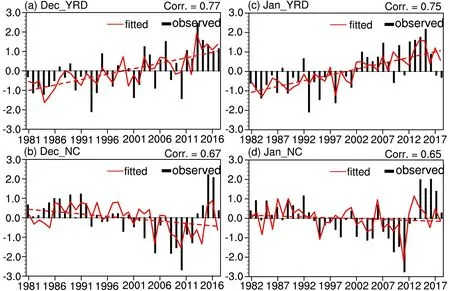
Fig.6.Variation in the standardized observed HDs (black bars) and fitted HDs (red solid line) in the YRD in (a)December from 1981 to 2017 and (b) January from 1982 to 2018.Fitted detrended HDs plus the observed HDs’trend are fitted HDs,represented here by the red solid line.Red dotted lines represent their same trend line.The number on the right is the CC of the observed HDs and fitted HDs plus the trend (i.e.,the CC between the black bars and the red solid line).(c,d) As in (a,b) but in NC.
Similarly,CCs were calculated between circulation indices in January and JHD(JHD),as shown in Table 1,and the significant indices (exceeding the 95% confidence level) were selected to fit JHD(JHD).Three (five) circulation indices,including the AAC,SAT diff.and precipitation indices (the ACC,RH,PBLH,UV speed and precipitation indices),were demonstrated to be useful for the formation of JHD(JHD).The fitted circulation indices explain 56% (42%) of the variance of JHD(JHD)with the trend,indicating large contributions of these atmospheric circulations (Figs.6c and d).In Fig.7c,the AAC,SAT and precipitation all show corresponding results with JHDin the minimum (maximum) year of 1993 (2015).Meanwhile,in Fig.7d,five meteorological variables show corresponding results with JHDin the minimum year of 2011;however,only RH shows corresponding results with JHDin the maximum year of 2016.Regardless,meteorological and climate conditions play important roles in the interannual variabilities of HDs rather than other elements.
3.2.Comparison of atmospheric circulations associated with DHDNCand DHDYRD
The wave activity flux (WAF) demonstrates the wave energy propagation paths (Takaya and Nakamura,2001;Hsu and Lin,2007;Honda et al.,2009).A quasi-stationary planetary wave route (i.e.,the Scandinavia pattern) is apparent,with an anomalous negative center over Scandinavia and an anomalous positive center over Mongolia (Fig.2a).The CC between the Scandinavia pattern and DHDis−0.48 (significant at the 99% confidence level).In contrast,the WAF associated with DHD(Fig.2b) shows a positive EA/WR phase (CC=0.56).These results demonstrate that the Scandinavia and EA/WR patterns contribute to the variations of DHDand DHD,respectively.The AAC near Northeast Asia is located in the crossover regions of the Scandinavia and EA/WR patterns and might explain the close relationship between DHDand DHD.
Local meteorological conditions associated with DHDand DHDwere also compared (Figs.3—5).The climate-mean vertical motion is weak in the downward direction over the YRD (not shown),and the AAC enhances the anomalous descending movement (Fig.3a).Besides,anomalous reversion of the north—south temperature is favorable for DHD(Fig.3a),which restricts the invasion of the East Asian winter monsoon (EAWM) into the YRD.Low PBLH also restricts the vertical dispersion (Fig.3c).Against the background of intensive descending motion over the YRD,dry air is carried from the top to the ground,causing the weak negative RH anomaly (Fig.3a) and less precipitation.As we know,some pollutants can be removed via wet removal,i.e.,precipitation,especially in southern areas with large precipitation.In Fig.4a,precipitation has a negative CC with DHD(CC=−0.34,≥ 95% confidence level).Local meteorological conditions related to DHDare correspondingly discussed (Figs.5a and c).Different from DHD,anomalous upward movement (Fig.5a),southerly wind near the surface (Fig.5a),high RH (Figs.5a and S2c),high surface temperature (Fig.5a),high potential of temperature inversion (Fig.S2b),and low surface wind speed(Fig.S2a),are favorable for DHD.In addition,precipitation has little influence on the elimination of haze pollution over NC (Fig.4c),as compared to that over the YRD (Fig.4a).As shown in Figs.3c and 5c,the PBLH shows negative anomalies over both NC and the YRD,indicating a negative contribution to the elimination of haze pollution.
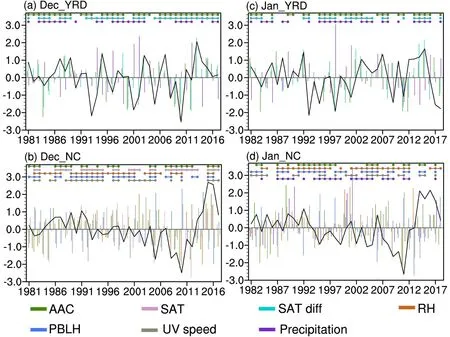
Fig.7.(a) Variation of December HDs (line) and associated significant meteorological variables (histogram) in the YRD from 1981 to 2017.(b) As in (a) but in NC.(c) Variation of January HDs (line) and associated significant meteorological variables (histogram) in the YRD from 1982 to 2018.(d) As in (c) but in NC.Dark green,pink,cyan,brown,blue,gray,and purple solid circles at the top indicate the same or opposite signs between HDs and meteorological variables (AAC,SAT,SAT diff.,RH,PBLH,UV speed,precipitation) according to the CCs in Table 1.The linear trends of all data were removed.
It is common knowledge that the wintertime weather and climate of East Asia is affected by the EAWM,so the monthly EAWM [i.e.,the East Asian December (January)monsoon,abbreviated as EADM (EAJM)]was separately analyzed to study the effects on DHDand DHD.Here,the definitions of the EADM and EAJM refer to previous studies (Wang and Jiang,2004;He and Wang,2012) and are shown in Table S1 (in the ESM),including the sub-indices and synthetic index.The CCs of the EADM and DHD(DHD) show that specific members,such as the East Asian deep trough,westerly jet,as well as the synthetic index,have an influence on DHD,while all members of the EADM have a significant impact on DHD(Table 2).The question,then,is how does the EADM affect DHDand DHD? A strong EADM may weaken the temperature difference between the north and south of the YRD (Fig.8a)and bring cold air from the mid—high latitudes to China.Meanwhile,there is sufficient water vapor in the YRD,so the intrusion of cold air may enhance the precipitation over the YRD (Fig.8b).When precipitation increases,haze pollution in the YRD will be removed.In addition,a strong EADM may also increase the surface wind speed in theYRD (not shown),strengthening the conditions of horizontal dispersion.As for DHD,a strong EADM may lead to favorable local ventilation conditions and unfavorable growth conditions for haze particles,such as low SAT (Fig.8c),low RH (Fig.8d),high PBLH (Fig.8e),and high surface wind speed (Fig.8f).
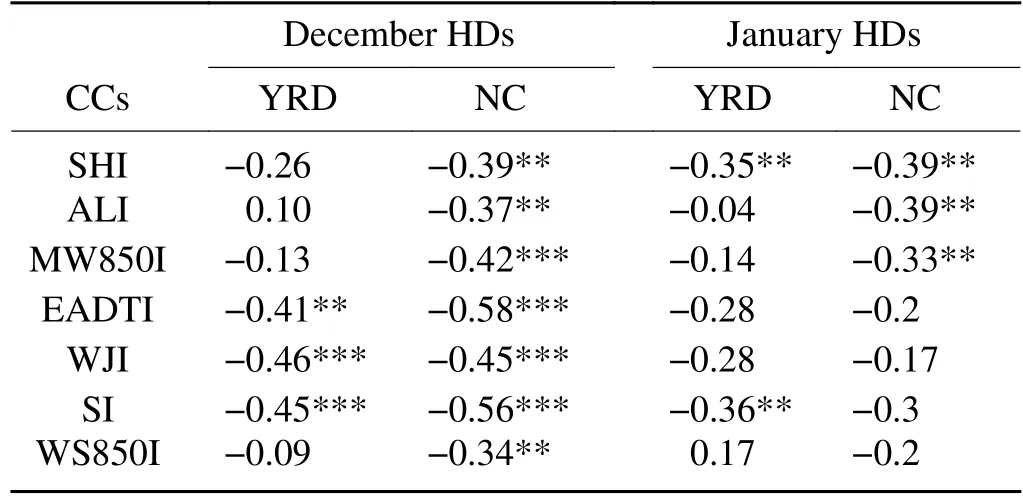
Table 2.The CCs between East Asian early winter (December and January) monsoon indices and HDs of two areas (the YRD and NC) in December and January,respectively.Double asterisks(**) and triple asterisks (***) indicate the results pass the 95% and 99% confidence level,respectively.
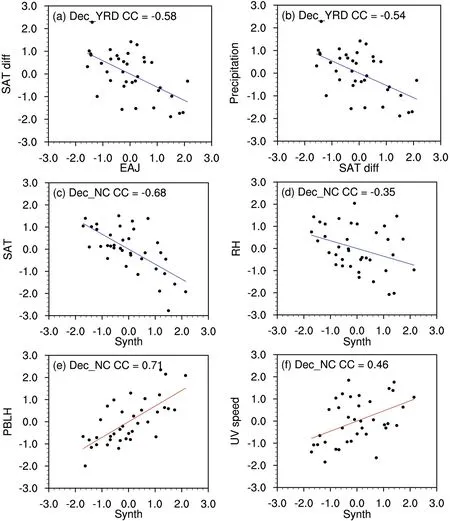
Fig.8.Scatterplot of (a) December East Asian jet index and December SAT diff.index between the north and south of the YRD,and (b) the December SAT diff.index between the north and south of the YRD and the December precipitation index of the YRD.Scatterplot of the East Asian December monsoon synthetic index and December (c)SAT index,(d) RH index,(e) PBLH index,and (f) UV speed index of NC.The linear trends in all data were removed.The straight lines are the lines of best fit,and the CCs indicate the CCs between two variables.
3.3.Comparison of atmospheric circulations associated with JHDNCand JHDYRD
The CCs of JHDand JHDbecome non-significant (Fig.1b),indicating weak synergistic variations of JHDand JHD.The associated wave-like train is significantly weakened (Figs.2c and d) in January rather than that in December.Consequently,the influence of Eurasian wave trains on local HDs is weakened.Local anticyclones affect local HDs in both areas,with CCs of 0.40 and 0.37(Table 1),significant at the 95% confidence level.Additionally,the AAC in January is also relatively weaker than that in December (Fig.2,Table 1).
It was shown in Zhong et al.(2019) that the directions of vertical motion vary according to the locations of the AAC.Because the YRD is located in the east of the bottom of the AAC (Fig.2c),descending motion was delivered to the region (Fig.3b).Although the descending motion only exists in the south of the YRD,other local meteorological conditions induced by the AAC,such as the SAT diff.(Fig.3b),weak UV speed (Fig.3d),anomalous southerly wind (Fig.3d),and less precipitation (Fig.4b),are crucial for high JHD.By contrast,for JHD,anomalous ascending motion(Fig.5b),high SAT (Fig.5b),high RH (Figs.5b and S3c in the ESM),anomalous southerly wind (Figs.5b and d),weak UV speed (Fig.5d),low PBLH (Fig.S3a),and high potential of temperature inversion (Fig.S3b),provide adverse conditions for the dispersion of haze particles.Besides,in January,precipitation makes different contributions to HDs over NC and the YRD,i.e.,more precipitation brings more JHD(Fig.4d).Light rain is dominant when precipitation happens over NC,which is conducive to the hygroscopic growth of haze particles.
As for the EAJM,the significant impact factors are the Siberian high index and synthetic index (Siberian high index,Aleutian low index and meridional wind at 850 hPa index) for JHD(JHD).Additionally,the influential process of the EAJM is as follows.A strong EAJM can reduce the temperature difference between the north and south of the YRD and enhance the precipitation over the YRD(Figs.9a and b).Meanwhile,for JHD,the Siberian high can affect local meteorological conditions (Figs.9c—e),including RH (Fig.9c),PBLH (Fig.9d),and UV speed (Fig.9e).In other words,a strong EAJM,represented by the Siberian high,creates an unstable environment for high JHD.
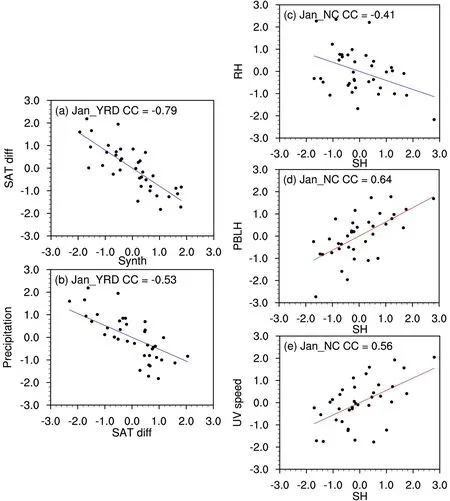
Fig.9.Scatterplot of (a) the East Asian January monsoon synthetic index and January SAT diff.index between the north and south of the YRD,and (b) the January SAT diff.index between the north and south of the YRD and the January precipitation index of the YRD.Scatterplot of the January Siberian high index and the January (c) RH index,(d) PBLH index,and (e) UV speed index of NC.The linear trends of all data were removed.The straight lines are the lines of best fit,and the CCs indicate the CCs between two variables.
4.Conclusions and discussion
Monthly haze pollution over the YRD and NC was investigated in early winter (i.e.,December and January),as well as the associated large-scale atmospheric circulations and local meteorological conditions (Fig.10).The DHD(DHD) is dominated by the Scandinavia (EA/WR) pattern in December,and these two wave trains degenerate into local AACs in January.In December,the DHD(DHD) is dominated by descending motion,the large temperature difference between the north and south,and less precipitation (ascending motion,high SAT,high RH,low PBLH,and weak UV speed).The precipitation is more important in January,and it makes a negative (positive) contribution to JHD(JHD).Most members of the EAWM make negative contributions to DHD and JHD over the two areas by affecting the local meteorological conditions.In fact,the locations of the study areas relative to the AAC might affect local circulations,according to Zhong et al.(2019).Because the YRD is located in the front of the AAC and NC at the back,it stimulates the descending (ascending)motion in the vertical direction for the YRD (NC) in both December and January,which results in the differences of local meteorological conditions,especially for the precipitation.

Fig.10.Schematic diagram of the subseasonal variation of the atmospheric circulation associated with haze pollution in the YRD and NC.The schematic of the YRD and NC in December (January) is on the left (right).Ellipses represent anomalous cyclones and anticyclones at high levels.Black (purple) curves on the left indicate the EA/WR(Scandinavia) pattern.Vertical arrows indicate the directions of vertical movement.Warm (cold) colors at the surface indicate warm (cold) anomalous surface air temperature.Green (red) clouds indicate positive (negative)anomalies of precipitation.Yellow crescents indicate a low boundary layer height.The purple (gray) box indicates the location of the YRD (NC).
Utilizing these significant circulation indices to establish regression models of HDs,results showed that these circulation indices make large contributions and can explained more than 40% of the variance of DHD,JHD,DHDand JHD.Owing to the switch in the observation methods of visibility in January 2014,the reliability of HDs after January 2014 has been tested.It was found that the conclusions are still robust if the data after January 2014 are removed.The collinearity of the indices can be ignored because the variance inflation factors of most selected factors are lower than five in the four regression equations(Fig.6).In Fig.11 in Zhang et al.(2019),the adverse weather conditions in autumn and winter might reduce the effect of emissions reduction in the Beijing—Tianjin—Hebei region in 2014 and 2015.Yin and Zhang (2020) investigated the pollution situation in the winters of 2017 and 2018 under almost the same emission conditions,finding that haze pollution rebounded in 2018 compared with that in 2017,indicating the important effect of climate and weather conditions.
Acknowledgements
.This research was supported by the National Key Research and Development Plan (Grant No.2016YFA0600703),the National Natural Science Foundation of China (Grant Nos.91744311,41991283 and 41705058),and the funding of the Jiangsu Innovation &Entrepreneurship Team.Electronic supplementary material:
Supplementary material is available in the online version of this article at https://doi.org/10.1007/s00376-020-0227-z.杂志排行
Advances in Atmospheric Sciences的其它文章
- Electronic Supplementary Material to:Monthly Variations of Atmospheric Circulations Associated with Haze Pollution in the Yangtze River Delta and North China*
- Upper Ocean Temperatures Hit Record High in 2020
- Comprehensive Marine Observing Experiment Based on High-Altitude Large Unmanned Aerial Vehicle (South China Sea Experiment 2020 of the“Petrel Project”)
- IAP’s Solar-Powered Unmanned Surface Vehicle Actively Passes through the Center of typhoon Sinlaku (2020)
- Distinctive MJO Activity during the Boreal Winter of the 2015/16 Super El Niño in Comparison with Other Super El Niño Events
- Which Features of the SST Forcing Error Most Likely Disturb the Simulated Intensity of Tropical Cyclones?
